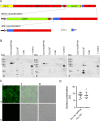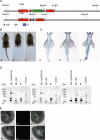Activity of the mouse Notch ligand DLL1 is sensitive to C-terminal tagging in vivo
- PMID: 34583743
- PMCID: PMC8477538
- DOI: 10.1186/s13104-021-05785-4
Activity of the mouse Notch ligand DLL1 is sensitive to C-terminal tagging in vivo
Abstract
Objective: The mammalian Notch ligand DLL1 has essential functions during development. To visualise DLL1 in tissues, for sorting and enrichment of DLL1-expressing cells, and to efficiently purify DLL1 protein complexes we tagged DLL1 in mice with AcGFPHA or Strep/FLAG.
Results: We generated constructs to express DLL1 that carried C-terminal in-frame an AcGFPHA tag flanked by loxP sites followed by a Strep/FLAG (SF) tag out of frame. Cre-mediated recombination replaced AcGFP-HA by SF. The AcGFPHAstopSF cassette was added to DLL1 for tests in cultured cells and introduced into endogenous DLL1 in mice by homologous recombination. Tagged DLL1 protein was detected by antibodies against GFP and HA or Flag, respectively, both in CHO cells and embryo lysates. In CHO cells the AcGFP fluorophore fused to DLL1 was functional. In vivo AcGFP expression was below the level of detection by direct fluorescence. However, the SF tag allowed us to specifically purify DLL1 complexes from embryo lysates. Homozygous mice expressing AcGFPHA or SF-tagged DLL1 revealed a vertebral column phenotype reminiscent of disturbances in AP polarity during somitogenesis, a process most sensitive to reduced DLL1 function. Thus, even small C-terminal tags can impinge on sensitive developmental processes requiring DLL1 activity.
Keywords: AcGFP; DLL1 C-terminal tagging; DLL1 hypomorph; Mouse DLL1; StrepFLAG.
© 2021. The Author(s).
Conflict of interest statement
The authors declare that they have no competing interests.
Figures


References
MeSH terms
Substances
LinkOut - more resources
Full Text Sources
Molecular Biology Databases

